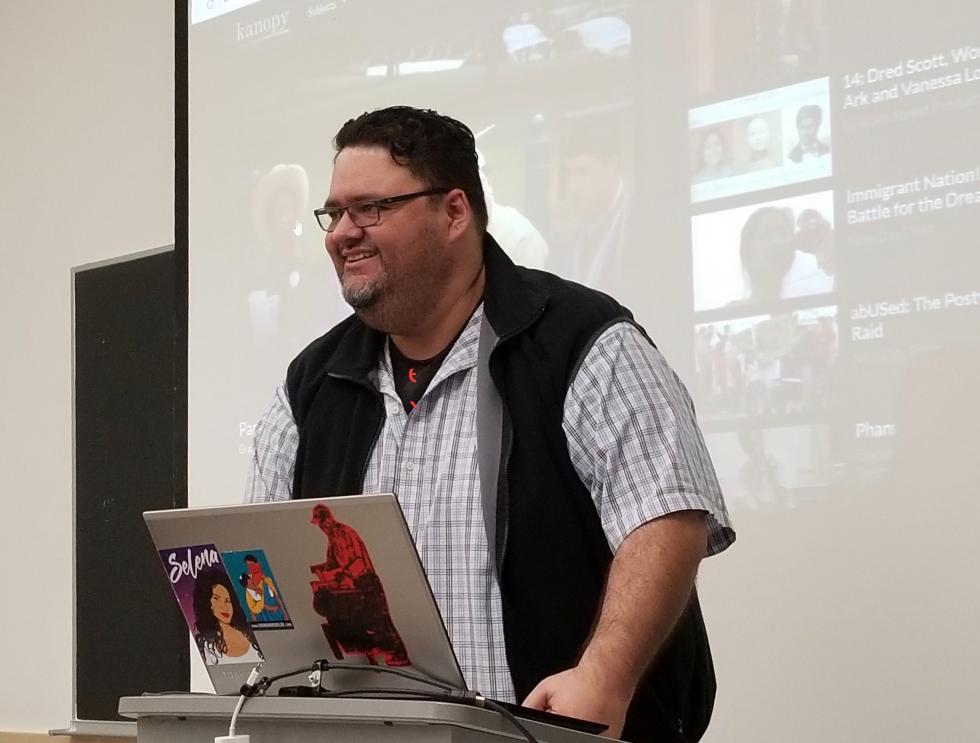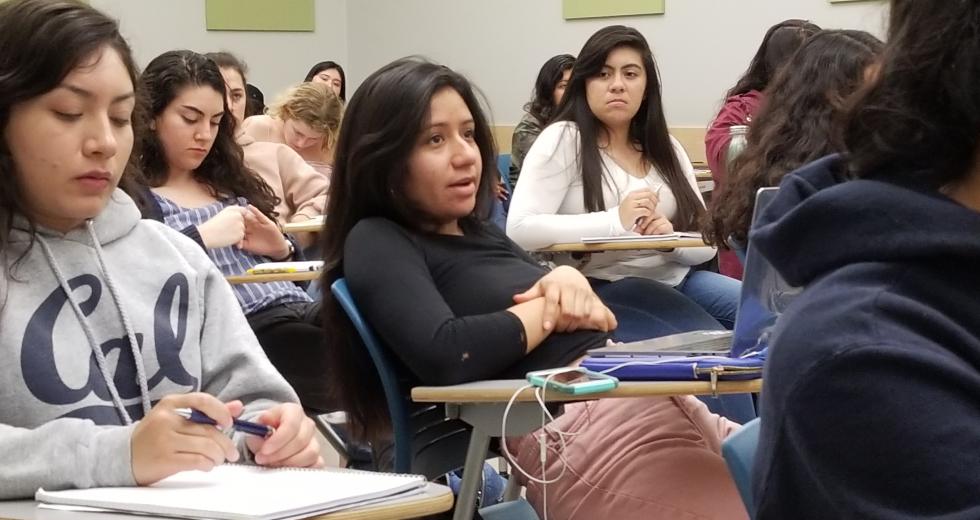In the middle of a talk on immigration policy, UC Berkeley lecturer Pablo Gonzalez suddenly gets personal. Standing at the front of a windowless classroom on this prestigious public university campus, he recounts how his mother and other women in his West Berkeley neighborhood each year would mark the anniversary of their arrival to the United States.
They would make a mile-long pilgrimage from their homes to a local church, he says—“all these Mexican women walking up the street, taking up space.” Afterwards, they’d go to lunch.
“These are the traditions that the production of illegality stops,” Gonzalez says. His students nod in recognition. Chicano/Latino Studies majors and minors, they come from Fresno, East Palo Alto, Boonville. Many are the first generation in their families to go to college; some are undocumented.
In Gonzalez, an anthropologist who peppers his speech with Spanglish and references to pop culture figures like comedians Key and Peele, they see a kindred spirit.
“He’s just real,” said senior Juanita Ibarra. “He was brought up in the hood, so I can relate to him. I walk in here, and I don’t feel pressured to have to formulate my sentences a certain way. I can fully express myself and I don’t feel judged.”
Gonzalez is a rare role model on a campus where only 5 percent of faculty members are Latino. At most University of California campuses, Latinos comprise less than 10 percent of instructors—in a state where Latinos make up nearly a quarter of UC undergrads and more than half of graduates from public high schools.
Latinos are similarly underrepresented among California State University and community college faculty, according to a report on campus diversity released last week by the Campaign for College Opportunity, an organization promoting college access for Californians.
Although other ethnic groups are also disproportionately absent among faculty, the underrepresentation of Latinos is especially striking given their demographic dominance in California.
“Diversifying the professoriate is interconnected with the future of the academic disciplines themselves,” said Alberto Ledesma, an assistant dean for diversity, inclusion and equity at Berkeley. “You need to be able to expand to these new communities because that’s where your students are coming from.”
Latino students find mentors from a variety of cultural backgrounds and academic departments. But some said having support from professors who share their roots made the difference between success and failure at a high-pressure campus.
Sandra Vences, 29, transferred to UC Berkeley from San Diego City College in 2015. She wanted to be a nurse practitioner and signed up for organic chemistry, but struggled to finish it. She gravitated towards Chicano/Latino studies, where she ended up majoring, building relationships with Gonzalez and other Latino professors whom she found approachable.
Soon she was leading other students on a service and learning trip to Arizona, focusing on immigration issues. She’ll graduate this spring and still plans to enter nursing, but is also applying for a fellowship at the state Capitol to better understand health policy.
“Honestly, I don’t think I would have survived in any other major,” she said.
A lack of Latino faculty may also hinder UC campuses’ ability to diversify their student bodies in the first place. The difference between the percentage of Berkeley students who are Latino and the proportion of California’s high-school graduates who are is bigger than at any other state’s flagship public university, according to The Hechinger Report, a non-profit news organization focused on inequality in education.
UC Berkeley lecturer Pablo Gonzalez speaks to students during a
class on Mexican immigration to the United States. Photo by
Felicia Mello for CALmatters

But the gap affects something even more fundamental, said Gregg Camfield, vice provost for faculty at UC Merced: the questions researchers ask and how they answer them.
“There’s a big Western bias toward the individual great mind, but we’re coming to understand that most of the world’s problems are extremely complex,” he said, “and we need to tap the perspectives and experience of a very wide range of people in order to solve them.”
Designed for 35 students, Gonzalez’s classes on Chicanos, Law and Criminal Justice, Mexican Immigration and Chicano Culture brim with 50 to 60. “It’s not healthy whatsoever, but those are 160 students I want to have a conversation with,” says Gonzalez, who lacks tenure.
His cozy fifth-floor office rarely empties, as students continually stop by to chat or seek advice.
“I say ‘this door, as long as it’s open, you can come in.’ The students see a lot of closed doors outside of school because of how they look, who they are, who they are becoming,” he says. “I try to make sure they know that this is their space.”
Born just down the street from the wooded campus, Gonzalez grew up in working-class neighborhoods of Berkeley and Richmond, majoring in Chicano Studies at UC Berkeley before heading to the University of Texas for graduate work in anthropology.
“I had never been to a place where in every field of study, there was Latino faculty,” he says of those years in Texas. “It had me thinking, ‘how do you continue that, but then also (create) the next generation?’”
Mentoring students, he decided, would be a central part of his career. Last year, as anti-immigrant rhetoric filled the airwaves and police descended on Berkeley’s campus in response to planned alt-right events, the knocks on his door became more frequent. Some students had family members being deported, or wanted to know whether they should reapply for Deferred Action for Childhood Arrivals, the program that granted temporary legal status to some immigrant students but is currently in limbo. A few were experiencing mental breakdowns.
“My students still feel that sense of stigma that they don’t belong,” he says. “As an educator, you’re up there, and you have to be their lighthouse. They’re navigating so much. They want to see that there’s at least a path for them to get through. And we have to build way more lighthouses because they’re navigating really blind.”
Rising competition, the demise of affirmative action, and the concentration of California’s Latino undergraduates at less-prestigious universities all impede UC’s ability to recruit the next Pablo Gonzalez, said Alex Saragoza, who has taught Chicano/Latino Studies at Berkeley since the 1980s. A generation of faculty members hired before California’s Proposition 209 banned affirmative action on public university campuses is now retiring, with an insufficient number of candidates in the pipeline to replace them, Saragoza said.
“Part of the delay is that the majority of Latino students in four-year universities are not in top-tier institutions, and they have to face competition from people at the Princetons and the Yales and Harvards and Berkeleys in terms of getting to a top-tier graduate program that facilitates going on to a teaching career at the college level,” Saragoza said.
Yet a report on UC Berkeley’s Latino community released last year by a task force of students, faculty and administrators indicated the university could do more.
“Given the Latinx demographics approaching 50% in California, our miniscule representation on the Berkeley faculty is a glaring reminder that the campus must make a forceful commitment to identifying departments and fields where faculty [can] be aggressively recruited,” the report reads.
The UC system is developing a leadership program for Latino faculty and forming an advisory council that can recommend ways to address representation among both faculty and students, UC spokeswoman Claire Doan said. Fellowship and training programs, many privately funded, aim to attract more diverse candidates to graduate programs and faculty positions.
At UC Merced, the campus with the largest proportion of Latino professors at about 12 percent, faculty-nominated equity advisors strategize with search committee chairs about how to attract diverse candidates and combat implicit bias in hiring.
“We’re working constantly to make sure the pools we’re hiring from are sufficiently diverse,” said Camfield, the vice provost. “If they aren’t, we extend the search. We’re not willing to let faculty say, ‘Well, this is all we got.’ ”
“We’ve still got a long way to go,” he added, noting that Latinos make up about half of the campus’s students. But he said the campus’s Central Valley location helps lure socially-engaged scholars—many of them from underrepresented backgrounds—who are motivated to solve the area’s myriad challenges, from air pollution to health disparities.
To change faculty demographics, experts say start with graduate students. That’s the focus of a five-year nationwide pilot program, Pathways to the Professoriate, that matches undergraduates from three universities where more than a quarter of students are Latino—California State University, Northridge, the University of Texas at El Paso and Florida International University—with mentors at five major research universities, including UC Davis and UC Berkeley.
The students attend a six-week bootcamp on research skills and applying to graduate school, receive funding to conduct independent research, and work with mentors on their CVs and essays. Sponsored by the Penn Center for Minority Serving Institutions, the program has helped identify barriers Latino undergraduate applicants may face.
Their schools often lack the resources to sponsor summer research programs, or don’t offer languages that might give students a leg up in their fields, said Heidi Schumacher, who directs the Pathways program at Cal State, Northridge.
“We have students who commute hours each day while getting good grades and working a full-time job,” she said. “That kind of grit and persistence is an indicator of their potential for success. But that doesn’t show up on a college transcript. So we’re asking the research universities, ‘How can we make what is great about these students legible to you?’ “
Eight Northridge students who participated in the program’s first group applied to schools this spring. Combined, they have received more than 20 offers of admission with full funding from graduate programs across the country, said Schumacher—including Northwestern, the University of Minnesota and the University of Michigan.
But just one was accepted to UC Davis, she said, and none to UC Berkeley.
This story and other higher education coverage are being supported by the College Futures Foundation.
CALmatters.org is a nonprofit, nonpartisan media venture explaining California’s policies and politics.



